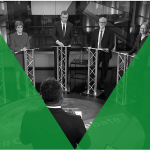
Dr James Morrison
Reader in Journalism, Robert Gordon University
Email: j.g.morrison@rgu.ac.uk

Section 7: News and Journalism
- Time to fix our TV debates
- What was all that about, then? The media agenda in the 2019 General Election
- Hero and villain: the media’s role in identity management
- Traditional majoritarian conceptions of UK politics pose a dilemma for the media in elections
- #GE2019: A tale of two elections?
- Boxing clever: negotiating gender in campaign coverage during the 2019 General Election
- Press distortion of public opinion polling: what can, or should, be done?
- The final verdict: patterns of press partisanship
- The class war election
- An uncertain future for alternative online media?
What should pluralistic punditry look like in a multi-party parliamentary democracy? How should a state-owned broadcaster’s flagship political show populate its panels before elections to guarantee balance between Left, Right and Centre, eliminate perceptions of bias, and maintain that most disputed measure of fairness: impartiality?
When BBC2’s Politics Live was unveiled as a snappier, social media-friendly successor to long-running Westminster digest The Daily Politics in July 2018, the announcement was couched in studiedly public service-tinged terms: as part of a package of improved “political and parliamentary output” designed to deliver “trusted impartial” coverage and combat “concerns about misinformation and ‘echo chambers’”. These bold claims have since been tested through producer Rob Burley’s tortuous explanations of his efforts to calibrate the show’s party-political balance on Twitter. “The fact that Party X is on a programme on one day and Party Y is not does not mean the programme is being unfair on Party Y”, he pre-emptively tweeted days before the launch of the 2019 election campaign, because “on future programmes Party Y will appear”. This meant that, “over the course of a series or an election period”, the show would achieve “the correct balance between the parties”.
But how realistic is it to expect viewers to stay tuned to a programme for weeks or months in order to be exposed to a fair spread of coverage? And how does Politics Live’s peculiar mode of impartiality measure up – even judged on its own, debatable, terms?
A provisional breakdown of on-air contributors to the show between 2 September 2019 (the start of its second series) and 11 December (the final day of the election campaign) suggests the balance between pundits one might broadly categorise as Left and Right was roughly equal. Each ‘wing’ enjoyed around 33% of the limelight, with the Left actually enjoying a marginal advantage (at 160 to the Right’s 158) if the Scottish National Party (SNP), Plaid Cymru and Greens were bracketed alongside Labour. But throwing a further 10 ‘libertarian’ contributors into the mix, including stalwart Left antagonists Brendan O’Neill, editor of Spiked, and fellow ex-communist contrarian Claire Fox (now a Brexit Party MEP), it seems safe to characterise the overall Left/Right balance as broadly fair.
Viewed through a strictly party-political lens, however, the breakdown begins to vindicate Labour’s pre-election complaint about the BBC’s ‘anti-Labour framing’. Over the entire three-month period, the number of Conservative politicians interviewed on Politics Live was 65 (36% of the total), compared to Labour’s 62 (34%). Significantly, this imbalance proved especially stark during the ‘phony election’ phase: the period before stricter Ofcom impartiality rules formally kicked in. During this time, Tory MPs, MEPs and candidates outnumbered Labour ones by 41 to 35 (37% to 31%). Although the SNP, Plaid and Greens bolstered the Left’s representation by collectively notching up 23 contributors across the three months, their relative prominence (18, 3 and 2 slots respectively) might be justified by their real-world electoral standings at the time, particularly if these include vote-shares in the 2017 election (measures to which we return). More contentious, arguably, was the appearance across the period of 12 pundits from the Brexit Party – all but two of whom featured before the election was called. Though Nigel Farage’s party would be side-lined during the official campaign, it provided 9% of all panellists beforehand. This gave it an agenda-setting prominence that could only conceivably be justified in the context of its then recent European election success and defining contribution to the Brexit debate.
What, then, of the official campaign period? In the five weeks before polling-day Labour pundits actually outnumbered Tories by 27 to 24, though this Left/Right imbalance was easily offset by the inclusion of a disproportionate number of journalists from right-wing outlets and several ‘neutral’ contributors with normatively neoliberal agendas, notably the Institute for Fiscal Studies (IFS). A more telling pattern was declining visibility of the Centre – whose share of screen-time halved from 10% to 5% between phony election and campaign, as its Liberal Democrat standard-bearers were squeezed from 11% to 9%.
Arguably, this ‘Centrist squeeze’ merely reflected the wider polarisation of today’s political debate. But is this good enough? Discounting the most literal definition of pluralism – that all UK-wide parties should be given equal exposure, proportional representation-style, during an election campaign – shouldn’t Politics Live allot airtime based on individual parties’ real-world standing? Well, in some respects, it did: the Lib Dems’ 8.7% of screen-time compared to a 7.4% vote-share in the 2017 election. Yet if their exposure had been based on their most recent electoral successes we might have seen twice as much of them: the party’s 2019 European election vote-share was second only to the Brexit Party’s (20.3% to 31.6%). As this approach would have cut Labour’s airtime to just 14% and the Tories’ to 9%, however, it’s easy to see why achieving measurable impartiality remains such an editorial headache. Maybe Politics Live didn’t do such a bad job after all.
